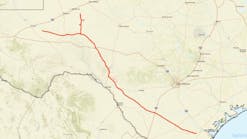RANK ORDOVICIAN WILDCATS STAKED IN NORTHERN MISSISSIPPI COUNTIES
G. Alan Petzet
Exploration Editor
Ordovician Knox dolomite is the objective at two rank wildcats in northern Mississippi.
The wells appear to be the first modern drilling to Ordovician in the area, about 400 miles southeast of prolific Cambro-Ordovician Arbuckle gas production discovered in late 1987 in Wilburton field, Latimer County, Okla.
Marathon Oil Co. plans a 12,500 ft Knox test at 1 Lay, in 27-25n-2e, in central Tallahatchie County, Miss., about 80 miles south of Memphis.
Nearly 100 miles southeast of Marathon's new stake, Pacific Enterprises Oil Co. (USA) plans to drill 1 Jenkins 8 1, in 8-19n-15e, to 10,800 ft or Ordovician.
Pacific Enterprises is conducting horizontal drilling elsewhere in the U.S. onshore. Ordovician in Mississippi is a dolomite that has exhibited fractured and vuggy porosity, but as far as is known, Pacific's 1 Jenkins 8-1 will be a vertical hole.
A lease play had escalated in northern Mississippi since ARCO Oil & Gas Co.'s 1987 Wilburton deep gas discovery (see map, OGJ, Feb. 12, p. 24).
Relatively little is known about Knox in that area, and the two wildcats will be closely watched.
SPARSE PRODUCTION
State records show that only two wells have produced oil or gas from Ordovician in Mississippi, although other wells have encountered good shows.
The state's first Ordovician gas production came from Texaco Inc. 1 Clyde Q. Sheely, in 28-19n-12e, Oktibbeha County. It was completed Jan. 1, 1971, for an initial potential of 599 Mcfd of gas through a 9/64 in. choke from perforations at 14,690 15,036 ft after treatment with 3,000 gal of acid. Total depth is 17,420 ft.
Cumulative production through Jan. 1, 1990, is 871.78 MMcf of gas from the well, now operated by Energy Properties Inc. Production in 1989 was 33.155 MMcf of gas.
The well discovered Maben field.
Mississippi's first Ordovician oil was produced from Magnolia Petroleum Co. 1-A Snow, in 27-13s-7e, Monroe County. Initial potential flow rate was 190 b/d of 35 gravity oil through a 114 in. choke with 250 psi flowing tubing pressure through Upper Knox dolomite perforations at 4,753-56 ft.
The well was completed Sept. 1, 1953, and abandoned Oct. 23, 1954, after producing 7,813 bbl of oil and 23,513 bbl of salt water, according to a May 1974 paper written by Frederic F. Mellen, a consulting geologist, for the American Association of Petroleum Geologists Bulletin.
The well discovered New Hope field and was 42 miles northeast of Maben field.
ORDOVICIAN GEOLOGY
The Texaco and Magnolia wells produced from the same general zone of Ordovician. Mellen's 1974 geologic note discussed 12 wells in Calhoun, Pontotoc, Tippah, Oktibbeha, Monroe, Tishomingo, DeSoto, Tunica, and Chickasaw counties that penetrated all or part of Ordovician and stated that large reservoirs may be present in the area.
He noted that the interval from the top of Ordovician to basement is known only from one penetration, the Exxon Co. USA 1 Fulgham, in 33 19n-12e, Oktibbeha County, to be nearly 7,000 ft thick. Total depth of that well is 21,376 ft.
Porosity is found in fractured and vuggy dolomite, sucrosic dolomite, secondarily dolomitized limestone, coquinoid or reef limestone, oolitic limestone, and chert residdum from post-Ordovician, early Silurian, lixiviation, he wrote. Mellon wrote that the Ordovician rocks of Mississippi occupy a subsurface volume of nearly 10,000 cu miles.
"These rocks are dominantly limestone and dolomite, containing minor quantities of shale, siltstone, sandstone, and chert. Most of these rocks were deposited in very shallow marine environments. Oil and gas shows are very common throughout the vertical and lateral distribution. Appreciable thicknesses of porous reservoir rocks have been logged."
Mellen continued, "Small and large faults, with vertical displacements of up to 4,000 ft or more, are present. Progressively steeper dips from the Nashville dome and the Pascola arch south into the present center of the Black Warrior basin would favor commercial accumulations of oil and natural gas in front of the structural shelf in both structural and stratigraphic traps.
Copyright 1990 Oil & Gas Journal. All Rights Reserved.

